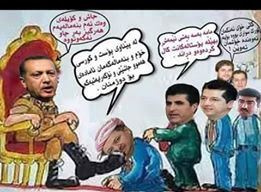As regards Iran's involvement in the ongoing conflict in Iraq, and how the United States initially disrupted the balance of power to Iran's advantage:
Iran has an interest in Iraq because of geopolitics and a will to control territory and natural resources.
When the United States overthrew Saddam Hussein and his Sunday regime in 2003, what the United States said was not going to introduce - a "new Iraq" with "democracy" - but what happened where the state collapsed in a clan society and that civil war broke out, a civil war mainly between different clans.
Sunni fought against Shia, but Sunni also fought against Sunni and Shia also fought against Shia, and in addition all the people in Iraq are enrolled.
After the civil war of 2006-2007, the conflicts and terrorism continued to hold more prominence in mainly the Sunni Arab triangles between Mosul and Baghdad.
When the United States during Barack Obama left Iraq in 2011, the Sunni extremists could take advantage of this deteriorating security situation, which ended with the fact that IS took over a third of Iraq in 2014.
In order to at least get some stability in Iraq while the United States was present in the country, turn to his enemy Iran.
Iran thus gained more and more power within the Iraqi government, and instead, instead, the United States received more Western influence, democracy and secularization in Iraq.
A Sunni regime was exchanged for a shiaregim, increased Islamization and sectarianism.
This disrupted the balance of power that had existed in the Middle East before 2003, where Saddam Hussein served as a wedge between Shiastrian Iran and Albanian-led Syria, and also as a opposition to al-Qaeda and other sectarian extremism.
When Saddam Hussein overthrew and Iran gained more power in the region, it experienced southern Saudi Arabia with its allied Gulf States who threatened and began to fund sunnixtremism.
Saudi Arabia has the United States in its back and Iran has Russia in its back.
Ultimately, this geopolitical super-power conflict in the Middle East is a single long continuation of World War II and Cold War.
One could call it an unconventional and low-intensive Third World War, where the United States and Russia globally, respectively, Saudi Arabia and Iran regionally fight through agents in countries such as Iraq, Syria and Yemen.
Iran wants geopolitically to have a corridor through Iran, Iraq, Syria and Lebanon to the Mediterranean. Through this corridor they could then transport gas and oil and sell it to Europe.
Russia and Syria President Bashar al-Assad support this.
Saudi Arabia also wants a corridor from Qatar through the same countries and out to the Mediterranean, in particular to sell gas to Europe.
Russia, Iran and Bashar al-Assad are against this.
The United States, on the other hand, supports Saudi Arabia in the form of their oldest allied state and business partner in the field of oil and also military in terms of security cooperation in the Middle East and arms trade.
This is what it's all about at the superpower level, and that involved states support groups on the ground is to use them to keep away common enemies.
By supporting the Kurdish federal government in northern Iraq, the United States keeps away Iran while protecting its oil investments and other business investment in the Kurdish areas, and by supporting Iraqi army forces, the United States helps to retain some of its control in southern Iraq as The other fears will get even more support from Iran.
And Iran, for its part, supports Iraqi al-Hashd al-Shaabi who opposes Kurdish separatism and a united Iraq, which with the government composition currently in Iraq would give more power to Iran.
























.jpg)
























































.jpg)
Inga kommentarer:
Skicka en kommentar